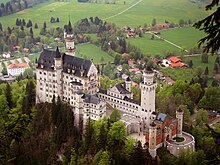Sightseeing
A sight is a significant natural monument , cultural monument or something otherwise attractive, spectacular or prominent that is often included in tourist programs. Often it is also about objects that the traveler already knows through the media (magazines, television, travel novels, etc.) and that he wants to experience independently. Some sights also serve as landmarks for a country, region or city.
Organizers, especially alternative city trips , criticize the term. Because it suggests that there are a few spectacular, prominent “worth seeing” places - while those of everyday life are usually not included. (They are at least as important for understanding.) From a tourism-critical perspective, it is emphasized that objects are not worth seeing per se , but that sights are designated as such by cultural authorities.
The target group also determines whether something is worth seeing for them. Typical sights are historical buildings and structures, also special evidence of contemporary history (e.g. remains of the Berlin Wall ) or a museum . Natural monuments can be lakes, vegetation zones or mountains.
See also
Sightseeing Germany
- Sights in Berlin
- Sights in Chemnitz
- Sightseeing in Darmstadt
- Sights in Gera
- Sightseeing in Karlsruhe
- Sights in Constance
- Sights in Memmingen
- Sights in Munich
- List of sights in Munster
- Sights on the Lower Rhine
- List of sights in Potsdam
- Sights in Regensburg
- List of sights in the Ruhr Valley
- List of sights in Saarland
- Most popular sights in Germany according to the German National Tourist Board
Sights international
additional
- Sights (stamp series)
- Landmark
- UNESCO world heritage
- Historic city center
- European Route of Industrial Heritage
Individual evidence
- ↑ Worn Beauties , in: Wiener Zeitung, July 25, 2013.
literature
- Burkhard Schnepel, Felix Girke, Eva-Maria Knoll (eds.): Culture all inclusive. Identity, tradition and cultural heritage in the age of mass tourism. transcript, Bielefeld 2013, ISBN 978-3-8376-2089-4 .
- Ingrid Thurner: Sights: construction and reception . In: Andreas Kagermeier, Albrecht Steinecke (ed.), Culture as a tourist location factor. University of Paderborn, Paderborn Geographical Studies on Tourism Research and Destination Management, Volume 23, 2011, pp. 1–17, ISBN 978-3-9811108-4-5 .



